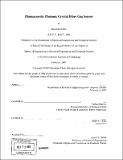| dc.contributor.advisor | Farhad Hakimi and Rajeev J. Ram. | en_US |
| dc.contributor.author | Chen, Raymond, M. Eng. Massachusetts Institute of Technology | en_US |
| dc.contributor.other | Massachusetts Institute of Technology. Dept. of Electrical Engineering and Computer Science. | en_US |
| dc.date.accessioned | 2008-04-23T14:36:23Z | |
| dc.date.available | 2008-04-23T14:36:23Z | |
| dc.date.copyright | 2007 | en_US |
| dc.date.issued | 2007 | en_US |
| dc.identifier.uri | http://hdl.handle.net/1721.1/41258 | |
| dc.description | Thesis (M. Eng.)--Massachusetts Institute of Technology, Dept. of Electrical Engineering and Computer Science, 2007. | en_US |
| dc.description | Includes bibliographical references (p. 89-93). | en_US |
| dc.description.abstract | Photoacoustic spectroscopy (PAS) is a form of laser spectroscopy that has demonstrated very high sensitivity for gas detection. Typically, PAS involves the absorption of a modulated laser beam by the gas species of interest, and the subsequent generation of acoustic waves at the modulation frequency. The amplitude of the acoustic signal, which can be measured by a microphone, can be amplified by several orders of magnitude with a properly designed gas cell used as an acoustic resonator. In recent times, hollow-core photonic crystal fiber (HC-PCF) has emerged as superior gas cell for standard absorption-based laser spectroscopy due to its small size, compatibility with fiber-based optical components, and easily attainable long light-gas interaction path lengths. However, the possibility of utilizing HC-PCF as a gas cell for PAS has yet to be explored. The size and structure of HC-PCF demands that a new method of PA signal detection must be proposed, because the conventional use of microphones for PAS is not applicable. This thesis describes the development of a proposed novel use of HC-PCF as a PA gas cell from theoretical support to experimental realization. A number of unresolved experimental issues prevented data on the performance of the constructed system from being obtained. These problems are discussed, and recommendations for further study, including several proposed measures to overcome these experimental issues, are made in the conclusion to the thesis. | en_US |
| dc.description.statementofresponsibility | by Raymond Chen. | en_US |
| dc.format.extent | 93 p. | en_US |
| dc.language.iso | eng | en_US |
| dc.publisher | Massachusetts Institute of Technology | en_US |
| dc.rights | M.I.T. theses are protected by
copyright. They may be viewed from this source for any purpose, but
reproduction or distribution in any format is prohibited without written
permission. See provided URL for inquiries about permission. | en_US |
| dc.rights.uri | http://dspace.mit.edu/handle/1721.1/7582 | en_US |
| dc.subject | Electrical Engineering and Computer Science. | en_US |
| dc.title | Photoacoustic photonic crystal fiber gas sensor | en_US |
| dc.title.alternative | Photoacoustic PCF gas sensor | en_US |
| dc.type | Thesis | en_US |
| dc.description.degree | M.Eng. | en_US |
| dc.contributor.department | Massachusetts Institute of Technology. Department of Electrical Engineering and Computer Science | |
| dc.identifier.oclc | 213413171 | en_US |
